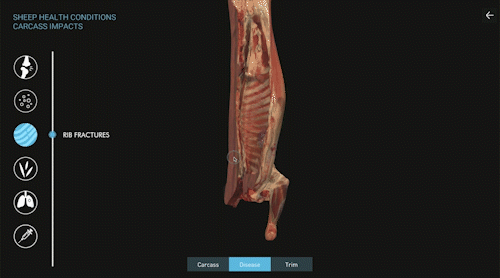Enhanced Abattoir Surveillance program
Program changes in 2022
Livestock SA is facilitating discussions with relevant stakeholders to transition the SA sheep industry funded Enhanced Abattoir Surveillance (EAS) program to national data reporting systems.
From 1 January 2022, PIRSA is no longer managing the abattoir surveillance program in South Australia. Producers will no longer be receiving carcass condition results via emails or printed letters from PIRSA. The transition to a national system is also likely to impact the monitoring and reporting of OJD for producers who have ‘opted in’ to this voluntary scheme.
Routine processor condemnation information from Thomas Foods International (TFI) to producers will continue.
Historical EAS factsheets, annual and benchmarking reports will remain available on the PIRSA website to provide relevant supporting information to producers during the transition period.
Producers will be advised by Livestock SA when the new program model is operational.
About the EAS program
From 2007 to 2021 the Enhanced Abattoir Surveillance program provided health condition and disease feedback to SA producers for sheep that have been processed at TFI South Australian abattoirs. The program monitored and reported on up to 21 sheep carcass diseases/conditions.
During this 15-year period, more than 28 million sheep have been inspected, from 118,000 lots. Over 62,000 emails or letters were sent to SA sheep producers to advise them of surveillance results.
The program has helped producers to:
- improve sheep health and welfare
- maximise farm productivity
- increase profits.
EAS has been constantly refined and updated to maximise the benefits of sheep surveillance to at least 50% of commercial South Australian sheep producers.
The program has assisted industry with:
- reducing waste
- trade access and market opportunities
- sheep health and disease research.
How abattoir surveillance worked
Data was collected on the abattoir slaughter floor by meat inspectors (Australian Government Authorised Officers).
For each line of sheep, an estimated percentage was recorded for the sheep affected by a health condition or disease. Conditions occurring at less than a 5% level were recorded as zero. Hence, clean lines were defined as those with all conditions or diseases detected at less than 5% of the line.
This information was entered into a database at the abattoir and sent to PIRSA. Information was then checked to make sure the Property Identification Code and owner details provided by the abattoir matched the registration database.
South Australian producers who sent sheep directly to the abattoir then received surveillance results by email or letter.
Monitored diseases and conditions
View fact sheets about the diseases and conditions monitored by the program.
Impact from the diseases and conditions may be seen:
- on farm, through:
- reduced reproductivity
- cost of treatment
- culling
- at the abattoir, through:
- trimming
- downgrading
- penalties
- condemnations.
Sheep health conditions – carcass impacts tool
The 3D carcass impacts tool provides an interactive web experience for producers to better understand what sheep health conditions look like on a carcass.
The tool highlights 6 common conditions and shows the amount of carcass loss from trim at the processor:
- arthritis
- sheep measles
- pleurisy/pneumonia
- grass seeds
- rib fractures
- vaccination lesions.

Find out more about Sheep health conditions – carcass impacts.
EAS video series
The 6-part video series focuses on common sheep health conditions monitored through the Enhanced Abattoir Surveillance program. Each video looks at the:
- prevalence of a condition in SA farms
- impact that a condition has on the carcass
- treatment and prevention options.
The videos all share a producer case study of how the EAS program data helped them identify and manage the conditions.
Annual report
Benchmarking reports
These documents provide valuable data to help producers measure their animal health performance against others within their region.
- 2020 Benchmarking Report – all SA regions ()
- 2020 Benchmarking Report – Adelaide Hills and Fleurieu ( or )
- 2020 Benchmarking Report – Barossa and Lower North ( or )
- 2020 Benchmarking Report – Eyre Peninsula ( or )
- 2020 Benchmarking Report – Kangaroo Island ( or )
- 2020 Benchmarking Report – Lower South East ( or )
- 2020 Benchmarking Report – Mid-South East ( or )
- 2020 Benchmarking Report – Murray Mallee ( or )
- 2020 Benchmarking Report – Northern Pastoral ( or )
- 2020 Benchmarking Report – Upper South East ( or )
- 2020 Benchmarking Report – Yorke Peninsula and Mid North ( or )
Contact
For more information regarding the transition, contact Livestock South Australia:
Email: admin@livestocksa.org.au
Phone: (08) 8297 2299
